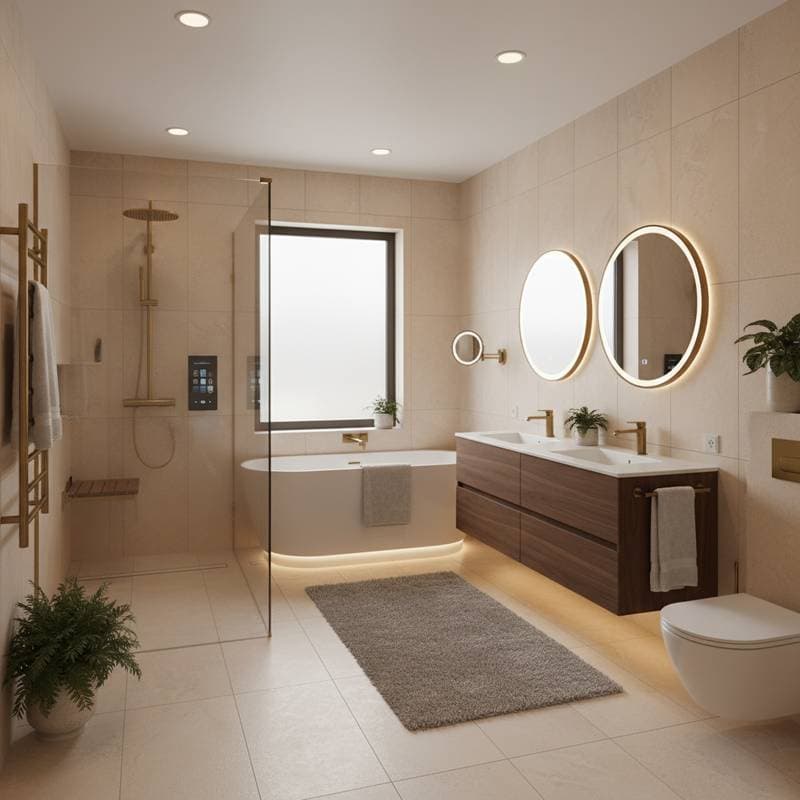New Walk-In Shower Codes Transform Bathroom Design in 2025
Imagine planning your bathroom remodel with visions of a sleek walk-in shower featuring frameless glass and seamless entry. This setup promises modern appeal and efficient space use, yet new accessibility codes introduce essential changes that reshape the entire process. Homeowners and contractors now navigate updated requirements that prioritize safety and inclusivity, influencing design choices from initial sketches to final inspections.
These evolving standards ensure bathrooms serve everyone effectively, and proper implementation allows you to achieve both compliance and aesthetic excellence. As an experienced content editor in home improvement topics, I have seen how these updates prevent common pitfalls while enhancing long-term functionality.
Understanding the Drive Behind Code Updates
Walk-in showers have surged in popularity, particularly when replacing traditional tubs with expansive, open designs. However, without careful attention to accessibility, these features can introduce risks such as uneven surfaces or restricted access that complicate use for various household members.
The primary motivation for these changes stems from a broader push toward universal design principles, which aim to create spaces that accommodate diverse needs without sacrificing style. By addressing potential hazards proactively, these codes promote environments where safety integrates seamlessly with everyday convenience, benefiting users across all life stages.
Key Requirements in the 2025 Accessibility Codes
The updated codes specify precise standards that builders must follow to ensure walk-in showers meet modern safety benchmarks. Here is a detailed look at the core elements:
-
Entry Width Specifications
Wider openings, typically at least 32 inches clear, facilitate easier access and minimize tripping hazards. This dimension accommodates mobility aids and provides ample room for comfortable entry, which proves especially valuable in shared bathrooms. -
Threshold and Curb Limitations
Codes restrict threshold heights to one-half inch or less, enabling truly barrier-free transitions. Implementing this involves careful floor leveling and specialized drainage systems to maintain water containment without compromising safety. -
Floor Slope and Drainage Guidelines
A gentle slope, often between 1% and 2%, directs water efficiently to the drain while avoiding steep angles that could lead to slips. Combine this with robust waterproofing membranes to prevent leaks and ensure durability over time. -
Grab Bar Reinforcement Standards
Walls require internal blocking or reinforcement during construction, allowing for future grab bar installation without major renovations. Position these supports at standard heights of 33 to 36 inches to align with common accessibility needs. -
Control Placement Requirements
Position valves and handles within easy reach, typically 38 to 48 inches from the floor and accessible from outside the wet area. This setup allows users to adjust water temperature and flow safely before entering. -
Slip-Resistant Flooring Mandates
Materials must achieve a minimum coefficient of friction, often 0.6 or higher for wet conditions. Options like textured stone or anti-slip treated tiles provide both compliance and visual appeal, reducing fall risks significantly.
Incorporating these elements demands thoughtful material selection and precise measurements from the start.
Budget Considerations for Compliance
While these requirements may elevate initial expenses, they deliver substantial returns through enhanced safety and property value. For a basic setup using pre-made components that already meet slope and threshold rules, expect costs between $1,500 and $3,000.
Mid-level projects, involving custom tiling and reinforced structures, typically range from $6,000 to $12,000, offering a balance of personalization and code adherence. High-end options, complete with advanced features like radiant heating and premium enclosures, start at $15,000 and provide luxurious, fully compliant results.
Factor in potential savings from avoiding rework: non-compliant installations often lead to inspection failures and additional labor costs.
Project Timeline and Practical Management
Installation timelines vary, but most code-compliant walk-in showers complete within one to two weeks, accounting for demolition, plumbing, and finishing. During this period, arrange alternative bathing facilities to minimize disruption.
Secure permits early, as they are essential for structural or plumbing modifications, and schedule inspections to verify elements like drainage and reinforcement before enclosing walls. This structured approach streamlines the process and ensures smooth progression.
Choosing Between DIY and Professional Assistance
Certain aspects suit skilled homeowners, such as basic framing or tile application, yet critical components demand expert handling to guarantee compliance and performance.
Engage professionals for waterproofing, precise plumbing adjustments, and glass enclosure fitting, as these directly impact inspection outcomes and prevent issues like water damage. Consulting a licensed contractor from the outset provides clarity on local variations and helps tailor the project to specific code interpretations.
Enduring Advantages of Code-Compliant Designs
Adhering to these standards transforms potential limitations into opportunities for superior bathroom functionality. Such designs support aging in place, appeal to a broader market of potential buyers, and reduce daily risks for all users.
From my experience editing content for renovation publications, I have observed how these features often lead to higher satisfaction rates and fewer modifications later in life.
Implementing Your Walk-In Shower Project
Begin by researching local building regulations and discussing plans with professionals to align your vision with requirements. Measure spaces accurately for entry widths and control heights, and select materials that satisfy slip-resistance criteria.
With strategic planning, you create a walk-in shower that combines contemporary style, regulatory compliance, and practical usability, ensuring it serves your home effectively for years ahead.










